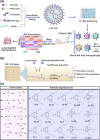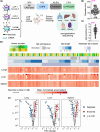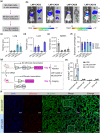High-throughput barcoding of nanoparticles identifies cationic, degradable lipid-like materials for mRNA delivery to the lungs in female preclinical models
- PMID: 38424061
- PMCID: PMC10904786
- DOI: 10.1038/s41467-024-45422-9
High-throughput barcoding of nanoparticles identifies cationic, degradable lipid-like materials for mRNA delivery to the lungs in female preclinical models
Abstract
Lipid nanoparticles for delivering mRNA therapeutics hold immense promise for the treatment of a wide range of lung-associated diseases. However, the lack of effective methodologies capable of identifying the pulmonary delivery profile of chemically distinct lipid libraries poses a significant obstacle to the advancement of mRNA therapeutics. Here we report the implementation of a barcoded high-throughput screening system as a means to identify the lung-targeting efficacy of cationic, degradable lipid-like materials. We combinatorially synthesize 180 cationic, degradable lipids which are initially screened in vitro. We then use barcoding technology to quantify how the selected 96 distinct lipid nanoparticles deliver DNA barcodes in vivo. The top-performing nanoparticle formulation delivering Cas9-based genetic editors exhibits therapeutic potential for antiangiogenic cancer therapy within a lung tumor model in female mice. These data demonstrate that employing high-throughput barcoding technology as a screening tool for identifying nanoparticles with lung tropism holds potential for the development of next-generation extrahepatic delivery platforms.
© 2024. The Author(s).
Conflict of interest statement
L.X. and M.J.M. have filed a patent application on this research. D.W. is named on patents that describe the use of nucleoside-modified mRNA as a platform to deliver therapeutic proteins and vaccines. D.W. and M.G.A. are named on patents describing the use of lipid nanoparticles for nucleic acid delivery. The other authors declare no competing interests.
Figures





Similar articles
-
Ionizable lipid nanoparticles encapsulating barcoded mRNA for accelerated in vivo delivery screening.J Control Release. 2019 Dec 28;316:404-417. doi: 10.1016/j.jconrel.2019.10.028. Epub 2019 Oct 31. J Control Release. 2019. PMID: 31678653 Free PMC article.
-
Peptide-encoding mRNA barcodes for the high-throughput in vivo screening of libraries of lipid nanoparticles for mRNA delivery.Nat Biomed Eng. 2023 Jul;7(7):901-910. doi: 10.1038/s41551-023-01030-4. Epub 2023 May 1. Nat Biomed Eng. 2023. PMID: 37127709
-
The replacement of helper lipids with charged alternatives in lipid nanoparticles facilitates targeted mRNA delivery to the spleen and lungs.J Control Release. 2022 May;345:819-831. doi: 10.1016/j.jconrel.2022.03.046. Epub 2022 Mar 26. J Control Release. 2022. PMID: 35346768 Free PMC article.
-
Delivering the right message: Challenges and opportunities in lipid nanoparticles-mediated modified mRNA therapeutics-An innate immune system standpoint.Semin Immunol. 2017 Dec;34:68-77. doi: 10.1016/j.smim.2017.08.015. Epub 2017 Sep 7. Semin Immunol. 2017. PMID: 28890238 Review.
-
Environment-Responsive Lipid/siRNA Nanoparticles for Cancer Therapy.Adv Healthc Mater. 2021 Mar;10(5):e2001294. doi: 10.1002/adhm.202001294. Epub 2020 Dec 4. Adv Healthc Mater. 2021. PMID: 33615743 Review.
Cited by
-
Multiarm-Assisted Design of Dendron-like Degradable Ionizable Lipids Facilitates Systemic mRNA Delivery to the Spleen.J Am Chem Soc. 2025 Jan 15;147(2):1542-1552. doi: 10.1021/jacs.4c10265. Epub 2025 Jan 1. J Am Chem Soc. 2025. PMID: 39742515
-
Machine Learning and Artificial Intelligence in Nanomedicine.Wiley Interdiscip Rev Nanomed Nanobiotechnol. 2025 Jul-Aug;17(4):e70027. doi: 10.1002/wnan.70027. Wiley Interdiscip Rev Nanomed Nanobiotechnol. 2025. PMID: 40813104 Free PMC article. Review.
-
Lung-Specific mRNA Delivery by Ionizable Lipids with Defined Structure-Function Relationship and Unique Protein Corona Feature.Adv Sci (Weinh). 2025 Apr;12(14):e2416525. doi: 10.1002/advs.202416525. Epub 2025 Feb 18. Adv Sci (Weinh). 2025. PMID: 39965058 Free PMC article.
-
mRNA lipid nanoparticle formulation, characterization and evaluation.Nat Protoc. 2025 Mar 11:10.1038/s41596-024-01134-4. doi: 10.1038/s41596-024-01134-4. Online ahead of print. Nat Protoc. 2025. PMID: 40069324 Free PMC article. Review.
-
Barcoded screening identifies nanocarriers for protein delivery to kidney.Nat Commun. 2025 Jan 21;16(1):899. doi: 10.1038/s41467-025-56257-3. Nat Commun. 2025. PMID: 39837887 Free PMC article.
References
MeSH terms
Substances
Grants and funding
LinkOut - more resources
Full Text Sources

